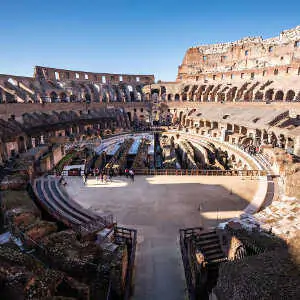Ancient Rome is famous for a number of grand things, but by far the biggest is their outstanding sporting arenas.
The famous Colosseum was the Roman Empire’s largest amphitheatre, but it was not, in fact, the largest stadium. With this title belonging to the Circus Maximus nestled just over a kilometre away.
The History of Circus Maximus
Its original structure was built in the 6th century BCE by the first Roman kings, making Circus Maximus the very first stadium ever built by the Romans. However, its design only took shape took during Julius Caesar’s reign in the 1st century BCE. Caesar did this by extending the seating tiers to be placed around the entire oval circuit. The main reason for the stadium was for chariot racing, also known as Ludi, which was one of the oldest games in Rome, played to honour the God Jupiter. The entire stadium could fit between 150,000 and 250,000 at a time, ensuring a very large crowd at every race!
Chariot Racing
Chariot racing was an extremely popular sport back in the ancient Romans time, with days that had chariot racing on, held were declared public holidays. and no business could be conducted. Making it quite surprising work got done at all seeing as the sport was held throughout the year, some years as many as 135 days.
Chariot Racing, or Ludi, involved included a form of a contest between small, two-wheeled chariots drawn by two to six horses. They were seen as the most extravagant events, even bigger than the famous gladiator fights. At the beginning of the race, the chariots were lined up together, with the Emperor at the time dropping a cloth to start the race. The race was notoriously dangerous, with both horses and racers suffering extreme injuries or death. Each racer had their colours, with the chariot and horses were brightly decorated with elaborate features.
Other Uses of Circus Maximus
Circus Maximus didn’t just include racing but also held a number of athletics, plays, beast-hunts, gladiator fights, and religious ceremonies. These typically opened with an extravagant parade, with the fighters and animals were displayed, showcasing the purposes of the game. Some of these events became legendary, with a beast hunt in 169 BCE, which involved 63 leopards, and 40 bears and elephants. Another time, there was even a chaotic fight between a group of gladiators and 20 elephants. However, once the Colosseum was built in the 1st century, the Circus Maximus became exclusively for chariot racing, until 549 AD, when the last race took place. After this, many of the local’s scavenge the area, taking the stones and other materials. Flooding also caused the stadium to be buried until a thick layer of alluvial soil and debris. Nowadays, very little of the original structure remains, with only a small section of the seating section visible.




